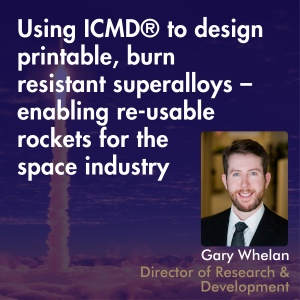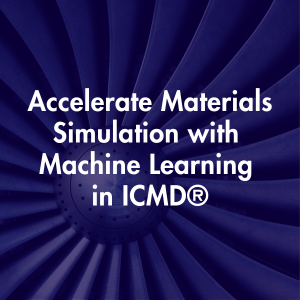WEBINARS
Our webinars outline the Integrated Computational Materials Engineering (ICME) approach and how it can be used to overcome materials challenges. We share how ICME can accelerate material development, optimize processes, predict material properties and more. The ICMD® materials design and engineering software is be showcased throughout our webinars.

Live webinars will resume in January 2026

 Using ICMD® to support solidification processes –from casting to additive manufacturing
Using ICMD® to support solidification processes –from casting to additive manufacturing
Watch recorded webinar
Presented by: Chris Hareland, Materials Design Engineer
This webinar will introduce viewers to aspects of QuesTek’s approach to designing alloys for solidification processes. Similarities and differences between equilibrium (e.g., casting) and non-equilibrium (e.g., solidification-based additive manufacturing) processes will be discussed. Three solidification phenomenon will be discussed to illustrate these concepts:
- Primary phase selection. The first phase to form from the melt can be different in equilibrium and non-equilibrium processes, particularly in stainless steels.
- The columnar-to-equiaxed transition. The underlying theory is the same for both equilibrium and non-equilibrium processes.
- Microsegregation. Classical models for equilibrium solidification can be modified to treat non-equilibrium solidification.
Learn about:
- Solidification phenomena relevant to both equilibrium and non-equilibrium processes.
- How ICME methodology can be used to address common challenges with solidification processing.
- How QuesTek’s ICMD® software can be used to analyze equilibrium and non-equilibrium solidification microstructures and properties.
 Using ICMD® to design printable, burn resistant superalloys – enabling re-usable rockets for the space industry
Using ICMD® to design printable, burn resistant superalloys – enabling re-usable rockets for the space industry
Watch recorded webinar
Presented by: Gary Whelan, Director of Research & Development
This webinar explores the challenge of designing nickel-based superalloys that are simultaneously printable, burn resistant, and strong enough for rocket applications, requirements often limited by strain age cracking in precipitation-strengthened alloys. Using QuesTek’s ICMD® platform, these tradeoffs in printability, burn resistance, and strength have been co-optimized through physics-based ICME modeling, leading to novel alloys that have been prototyped, tested, and fine-tuned with advanced microstructural characterization to accelerate alloy design and meet the demanding needs of aerospace propulsion.
Learn about:
- Integrated computational materials engineering
- Development of a novel printable alloy for Space applications
- QuesTek’s ICMD® software

Accelerate Materials Simulation with Machine Learning in ICMD®
Watch recorded webinar
Dr. Tanner Kirk walks through how ICMD® allows users to train ML models, such as Gaussian Processes, Decision Trees, and Symbolic Regression—on data from experiments, literature, or physics-based simulations. You’ll see how these models can be used independently or coupled with traditional models to enhance design workflows, fill data gaps, and accelerate materials development cycles.
Learn about:
• Practical application of ML regressors for materials property prediction
• Techniques for training and validating models in ICMD®
• Strategies for hybrid modeling: combining physics-based and data-driven approaches

Alloy Design for Additive Manufacturing using ICMD®
Watch recorded webinar
This webinar introduces viewers to aspects of QuesTek’s approach to designing alloys for additive manufacturing using ICME. In particular, the prediction and analysis of microstructural features unique to the additive manufacturing process will be addressed. Two case-studies will be used to illustrate the design concepts: Ferrium® PH48S & Inconel 625.
Learn about:
• Microstructural features of importance for additively manufactured metal alloys • How ICME can be used to address common challenges with additively manufacturing
• How to use QuesTek’s ICMD® software to analyze additively manufactured microstructures and properties

Functionally Graded Materials and Material Compatibility in ICMD®
Watch recorded webinar
In this webinar Dr. Tanner Kirk gives an overview of Functionally Graded Materials with a focus on the applications and challenges associated with compositionally graded alloys. The use of integrated computational materials engineering (ICME) to address challenges such as deleterious phases, thermal expansion mismatch, and hot cracking will also be discussed. Examples will be shown for how such calculations can be made in QuesTek’s ICMD® software platform for binary, ternary, or even higher dimensional material gradient systems.
Learn about:
• Functionally graded materials, compositionally graded alloys, and their applications
• How ICME can be used to address common challenges with gradient alloys
• How to use QuesTek’s ICMD® software to assess gradient compatibility

Using ICMD® materials design and engineering platform for Oil and Gas Applications
Watch recorded webinar
Integrated Computational Materials Engineering (ICME) is an approach to materials design, optimization, and insertion as well as solving challenges on implementation and selection of existing materials using a combination of physics-based modeling and machine learning methods. In this webinar QuesTek demonstrates how the ICMD® platform can be used to improve mechanical properties, corrosion properties, and processability of common structural materials used in oil country tubular goods (OCTG)

Driving Materials Innovation Through Collaborative Excellence
with ICMD®
Watch recorded webinar
QuesTek showcases collaborative materials innovation workflows within a team environment using the ICMD® materials design and engineering cloud platform. Explore unique cloud-enabled features that significantly enhance teamwork, efficiency, and productivity. Through real-world examples, compare traditional methods with the improved workflows now available on ICMD®, highlighting how these streamlined processes accelerate corporate R&D and drive faster innovation. Optimize materials development workflows with cutting-edge Integrated Computational Materials Engineering (ICME) technology alongside powerful cloud-based tools.
You’ll learn about:
• Using Software-as-a-service (SaaS) to enhance materials innovation
• Accelerating time-to-market and reducing costs with ICMD®
• Team collaboration and scalability through ICMD® SaaS

Designing Sustainable Alloys using ICMD®: Systems Design and Concept
Watch recorded webinar
QuesTek demonstrates a case study in sustainable alloy design using integrate computational materials engineering (ICME) and their ICMD® software platform. This is the first in a three webinar series on this case study that focuses on defining the materials challenge, properties of interest, the process-structure-property design chart for single crystal nickel, and the industry application that this alloy solves as well as the importance of re-designing the alloy to be more sustainable, both from an environmental impact perspective as well as for supply chain resilience.
You’ll learn about:
• Conceptual alloy design in an ICME framework
• Sustainable and supply chain resilient design
• Single crystal nickel alloys and their applications
• QuesTek’s ICMD® software

Designing Sustainable Alloys using ICMD®: Model Workflow and Calibration
Watch the recoded webinar
QuesTek demonstrates a case study in sustainable alloy design using integrated computational materials engineering (ICME) and their ICMD® software platform. This is the second in a three-webinar series on this case study that focuses on setting up and running the process-structure-property models relevant for this design, as well as calibrating them to experimental data using the built-in calibration tools in ICMD®. Attendance at the previous webinar(s) in this series is not necessary to follow along with the presentation. Each session includes a recap of the previous event.
You’ll learn about:
• Process-structure-property modeling for single
crystal nickel
• Optimization and calibration methods
• QuesTek’s ICMD® software

Designing Sustainable Alloys using ICMD®: Alloy Composition Design
Watch the recorded webinar
QuesTek demonstrates a case study in sustainable alloy design using integrate computational materials engineering (ICME) and their ICMD® software platform. This is the third in a three-webinar series on this case study that focuses on utilizing the calibrated process-structure-process modeling workflow defined in the previous two webinars to design a novel single crystal nickel alloy with reduced reliance on rare elements such as Rhenium. Attendance at the previous webinar(s) in this series is not necessary to follow along with the presentation. Each session includes a recap of the previous event.
You’ll learn about:
• ICME based alloy design
• Sustainability and supply chain resilient design
• QuesTek’s ICMD® software

Applications of Microstructure-Sensitive Fatigue Modeling
View this webinar on demand
Learn how Integrated Computational Materials Engineering (ICME) can be used to predict fatigue in real-world applications. Dr. Whelan describes the importance of microstructure analysis and focus on how it can improve alloy development, qualification, and sustainment activities.

Utilizing ICME to overcome materials challenges and accelerate alloy development
View this webinar on-demand
This webinar is the first in a series by QuesTek designed to introduce attendees to Integrated Computational Materials Engineering (ICME), the advantages it provides, and how it may be used to solve materials challenges. We discuss QuesTek’s new ICMD® software, its purpose, and its place within the Integrated Computational Materials Engineering (ICME) software landscape. We cover the currently available Toolkits for alloy optimization, design, and qualification, and key capabilities enabled by ICMD®.

Alloy Composition and Processing Optimization with ICMD® materials design software
View this webinar on-demand
QuesTek has been applying its Integrated Computational Materials Engineering (ICME) approach using its ICMD® materials design software to optimizing alloy compositions and manufacturing processes for a wide range of industries, pushing the limits of materials performance. The ICMD® platform integrates QuesTek Innovation’s proven library of models, genomic data sets, software, and analytics into a comprehensive SaaS product. The ICMD® platform and its toolkits enable materials design and simulation, informatics and analytics, qualification, and certification.

Accelerated Qualification and Certification of Materials with ICMD® materials design software
View this webinar on-demand
Accelerated Insertion of Materials (AIM) is a methodology for rapidly qualifying materials for specific applications by coupling modeling, simulation and testing across all stages of component and material development.
This allows for:
-rapidly iterating on design concepts that will be most beneficial to the target application,
-combining the aleatory uncertainty of the real manufacturing process and the epistemic uncertainty captured by simulation to predict distributions of material performance, and
-predicting minimum material properties on a full-scale production level using a minimum amount of experimental testing.

ICME applications for rapid additive manufacturing parameter set development
View this webinar on-demand

View this webinar on-demand

View this webinar on-demand

Designing Materials using ICMD®
View this webinar on-demand
This webinar introduces viewers to QuesTek’s systems-based materials design process. We discuss the benefits of computational design in material development and qualification and enabling materials concurrency in the product development cycle. Examples are showcased using QuesTek’s ICMD® software.

